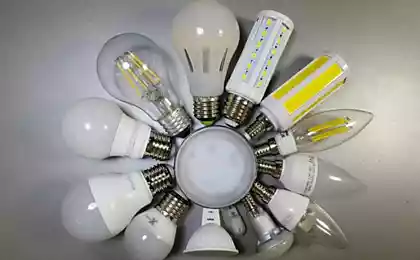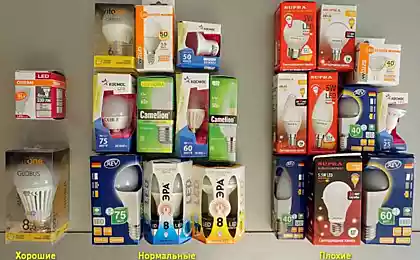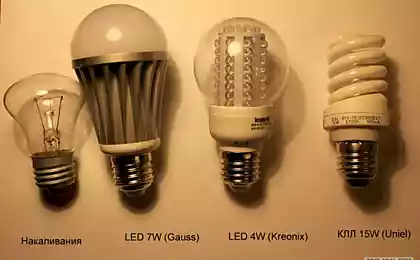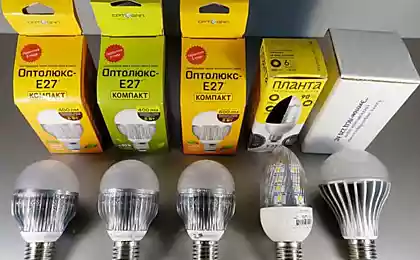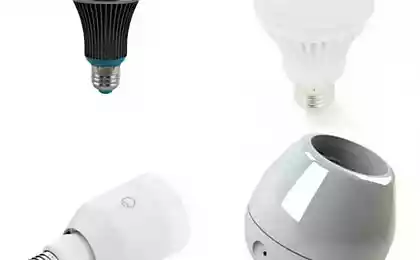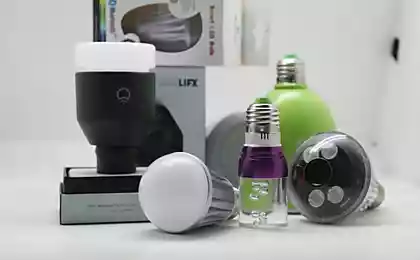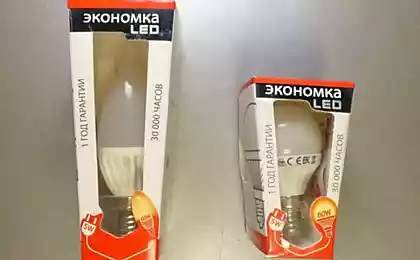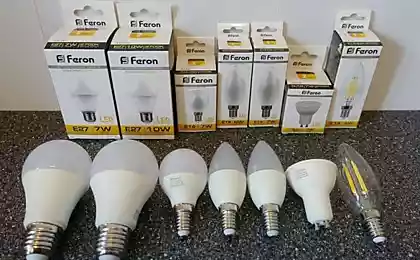1170
How to Compare LED lamp and an incandescent lamp
What kind of LED lamp, we have the right to be called a direct replacement lamp incandescent 60W, 75W, 100W ...?
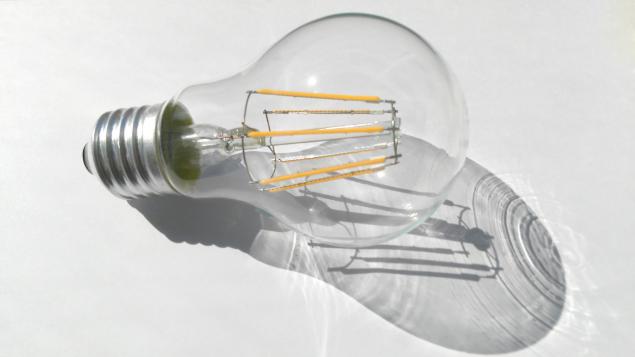
The correctness of matching LED lamps with incandescent lamps of luminous flux - one of the issues clarified as a result of public discussion of the evaluation criteria of the competition a > on Eurasian LIGHTING premium . The discussion was attended edition of the magazine "Light» , staff ВНИСИ them. Vavilov and experts NIIIS. A.N.Lodygina .
The minimum value of the luminous flux of incandescent lamps for domestic and similar general lighting sets the standard capacity "GOST R 52706-2007 Incandescent tungsten ...". Navigate in this document will help to a respectable following guidelines:
1) Type of base: E27. Or more - E27 / 27, which means the Edison screw base with a maximum thread diameter of 27 mm and a total length of 27 mm.

2) The supply voltage of 230 V. In Russia in 2003 the nominal voltage in the AC in accordance with GOST 29322-92 is the pan-European 230 V. In the seventh edition of the SAE, the publication of which was completed in the same year 2003, did not have time to make a correction and many still believe that "in 220 outlets».
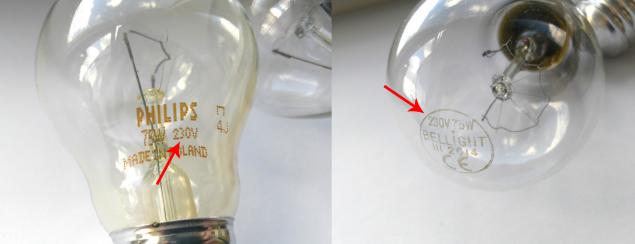
Incandescent lamps intended for use in AC 230V. I>
3) Luminous flux - «H», ie the corresponding coiled-coil lamps. Some are not made. (But since monospiralnye lamp has not been canceled, if the case goes to court, the manufacturer will be protected, indicating the luminous flux of lamps monospiralnyh «N».)

developed the double helix surface convective heat flux to the walls of the bulb per unit light-emitting surface of the thread is less than - greater efficiency. I>
4) The type is determined by the luminous flux for a lamp with clear bulb. Dairy bulb cover justifying the reduction of the luminous flux of 20% of the nominal value shall be disregarded. In normal operation, entering the field of view of a person such a bright object like a filament bulb or milk should be avoided. Incandescent bulb with milk - a compromise when used in decorative lamps without diffuser and protective angle, and its luminous flux may not be a guide.

For incandescent bulb with milk is allowed to decrease the luminous flux of 20% of face value, but that value can not be the benchmark for energy-saving lamps, regardless of the type of bulb. I>
5) Reducing the light output of bulbs during operation is not considered in the comparison, as is typical for any source, including LEDs. In this respect, a short time life incandescent lamps is its advantage, as forces regularly replaced with a new light source with luminous flux.
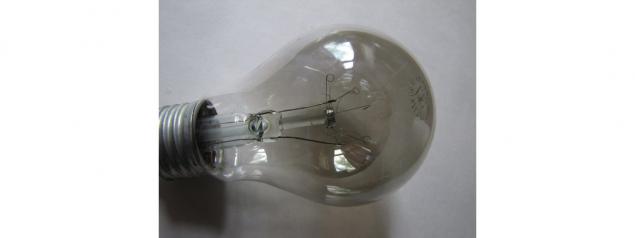
Steamy tungsten is deposited on the walls of the flask, and eventually reduces the luminous flux, but short lifespan incandescent defines frequent updating of the light source, and the restoration of the luminous flux of the lighting unit to nominal. I>
Now: minimum luminous flux for lamps, met all the requirements of GOST R 52706-2007:

The table shows that the LED lamp with a luminous flux of 600 lm is not equivalent to an incandescent lamp of 60 watts, and 1000 lm - is not equivalent to incandescent 100W. B> Even if a manufacturer makes a comparison with the existing only on paper monospiralnymi lamps.
Schedule zaivisimosti for the entire range of 25 ... 200 W:
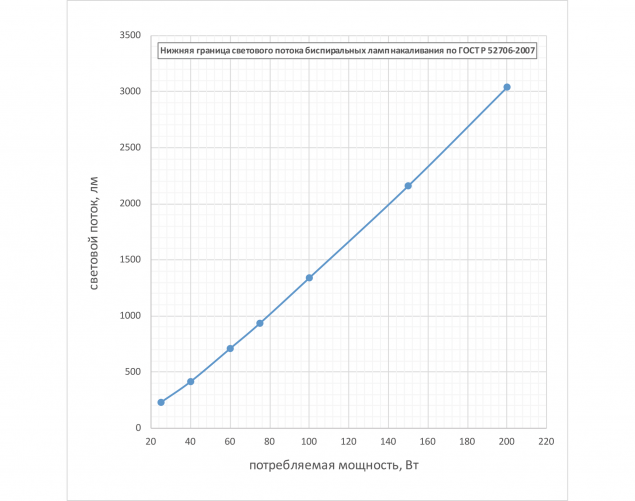
And large current portion 60 ... 100W.

If you ask the question - what is the lamp corresponds to an arbitrary light output, or use the above graph or calculate the ratio of luminous flux to a wattage incandescent.

It is seen that with increasing power efficiency of incandescent lamps is growing, but in the range of 60-100 W, in which the majority of the exploited today filament lamps and their counterparts, the luminous efficiency is slightly different from the average 12, 5 lm / W. And for a rough estimate of lamps with a luminous flux, for example, 860 lm can be made simple calculations 860 lm / 12, 5 lm / W = 68, 8 W and say that this lamp is the equivalent incandescent lamp approximately 70 watts. But as household lamps such capacity does not exist, and to the equivalent 75W bulb does not hold, correctly called this the equivalent incandescent lamp 60W.
_______________
The lamp on the main illustration with luminous flux 710 lm, 6 W and bought me ten days ago in a booth near the entrance of the plant "Lisma" for 190r. And then discussed at the session of the metrological III LIGHTING forum where Saransk experts have confirmed the correctness of the declared characteristics of this series of lamps.
Lamp bought after the tour of the factory where we were shown the production of incandescent light bulbs, the sales of which are growing in recent years due to the refusal of the population of the energy saving (but not dengosberegayuschih) CFL. Obviously, due to the rapid drop in prices for LED lamps in their high reliability (I finally gave up in favor of LED CFL about three years ago, and since then my house from a dozen LED bulbs are not out of order, no) demand for incandescent bulbs will soon fall again. And so Lisma in traditional glass case (cost 4p. 50 kopecks.) Puts a miniature LED driver and "threads". LED lamp turns out identical in appearance, size and weight of an incandescent bulb, which is designed to replace. And it really is equivalent luminous flux incandescent lamp of 60 watts.
The post was written to answer your questions, gather comments and suggestions, and taking into account the reviewers' comments to be published in the journal №4 for 2015 "Light." Until that moment, the publication of this information in any other edition of lighting equipment "is not genuine"). After the publication of these lines appear instead of a link. I>
Source: geektimes.ru/post/251716/

The correctness of matching LED lamps with incandescent lamps of luminous flux - one of the issues clarified as a result of public discussion of the evaluation criteria of the competition a > on Eurasian LIGHTING premium . The discussion was attended edition of the magazine "Light» , staff ВНИСИ them. Vavilov and experts NIIIS. A.N.Lodygina .
The minimum value of the luminous flux of incandescent lamps for domestic and similar general lighting sets the standard capacity "GOST R 52706-2007 Incandescent tungsten ...". Navigate in this document will help to a respectable following guidelines:
1) Type of base: E27. Or more - E27 / 27, which means the Edison screw base with a maximum thread diameter of 27 mm and a total length of 27 mm.

2) The supply voltage of 230 V. In Russia in 2003 the nominal voltage in the AC in accordance with GOST 29322-92 is the pan-European 230 V. In the seventh edition of the SAE, the publication of which was completed in the same year 2003, did not have time to make a correction and many still believe that "in 220 outlets».

Incandescent lamps intended for use in AC 230V. I>
3) Luminous flux - «H», ie the corresponding coiled-coil lamps. Some are not made. (But since monospiralnye lamp has not been canceled, if the case goes to court, the manufacturer will be protected, indicating the luminous flux of lamps monospiralnyh «N».)

developed the double helix surface convective heat flux to the walls of the bulb per unit light-emitting surface of the thread is less than - greater efficiency. I>
4) The type is determined by the luminous flux for a lamp with clear bulb. Dairy bulb cover justifying the reduction of the luminous flux of 20% of the nominal value shall be disregarded. In normal operation, entering the field of view of a person such a bright object like a filament bulb or milk should be avoided. Incandescent bulb with milk - a compromise when used in decorative lamps without diffuser and protective angle, and its luminous flux may not be a guide.

For incandescent bulb with milk is allowed to decrease the luminous flux of 20% of face value, but that value can not be the benchmark for energy-saving lamps, regardless of the type of bulb. I>
5) Reducing the light output of bulbs during operation is not considered in the comparison, as is typical for any source, including LEDs. In this respect, a short time life incandescent lamps is its advantage, as forces regularly replaced with a new light source with luminous flux.

Steamy tungsten is deposited on the walls of the flask, and eventually reduces the luminous flux, but short lifespan incandescent defines frequent updating of the light source, and the restoration of the luminous flux of the lighting unit to nominal. I>
Now: minimum luminous flux for lamps, met all the requirements of GOST R 52706-2007:

The table shows that the LED lamp with a luminous flux of 600 lm is not equivalent to an incandescent lamp of 60 watts, and 1000 lm - is not equivalent to incandescent 100W. B> Even if a manufacturer makes a comparison with the existing only on paper monospiralnymi lamps.
Schedule zaivisimosti for the entire range of 25 ... 200 W:

And large current portion 60 ... 100W.

If you ask the question - what is the lamp corresponds to an arbitrary light output, or use the above graph or calculate the ratio of luminous flux to a wattage incandescent.

It is seen that with increasing power efficiency of incandescent lamps is growing, but in the range of 60-100 W, in which the majority of the exploited today filament lamps and their counterparts, the luminous efficiency is slightly different from the average 12, 5 lm / W. And for a rough estimate of lamps with a luminous flux, for example, 860 lm can be made simple calculations 860 lm / 12, 5 lm / W = 68, 8 W and say that this lamp is the equivalent incandescent lamp approximately 70 watts. But as household lamps such capacity does not exist, and to the equivalent 75W bulb does not hold, correctly called this the equivalent incandescent lamp 60W.
_______________
The lamp on the main illustration with luminous flux 710 lm, 6 W and bought me ten days ago in a booth near the entrance of the plant "Lisma" for 190r. And then discussed at the session of the metrological III LIGHTING forum where Saransk experts have confirmed the correctness of the declared characteristics of this series of lamps.
Lamp bought after the tour of the factory where we were shown the production of incandescent light bulbs, the sales of which are growing in recent years due to the refusal of the population of the energy saving (but not dengosberegayuschih) CFL. Obviously, due to the rapid drop in prices for LED lamps in their high reliability (I finally gave up in favor of LED CFL about three years ago, and since then my house from a dozen LED bulbs are not out of order, no) demand for incandescent bulbs will soon fall again. And so Lisma in traditional glass case (cost 4p. 50 kopecks.) Puts a miniature LED driver and "threads". LED lamp turns out identical in appearance, size and weight of an incandescent bulb, which is designed to replace. And it really is equivalent luminous flux incandescent lamp of 60 watts.
The post was written to answer your questions, gather comments and suggestions, and taking into account the reviewers' comments to be published in the journal №4 for 2015 "Light." Until that moment, the publication of this information in any other edition of lighting equipment "is not genuine"). After the publication of these lines appear instead of a link. I>
Source: geektimes.ru/post/251716/
Chinese Entertainment: 4D simulator death
ALMA telescope team managed to get a detailed image of a distant galaxy
